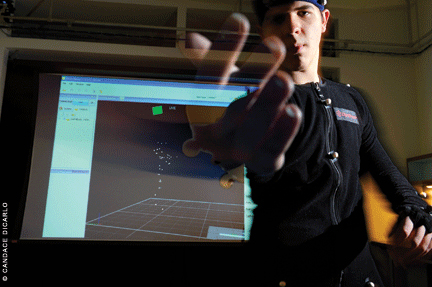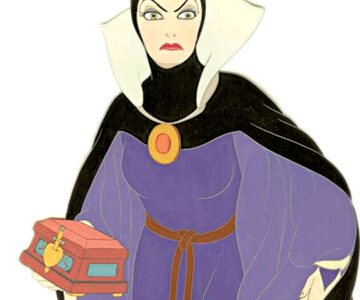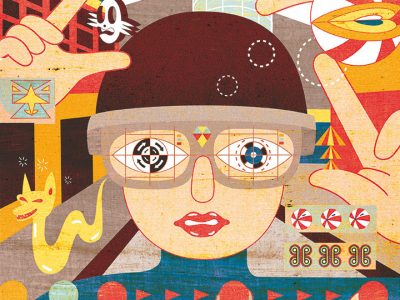
Here in the H. Stone Animation Studio, my son Jesse has been reduced to points of lights on a black screen. The motion-capture suit he’s wearing looks more like a Ninja outfit than an Invisibility Cloak, except that Ninjas usually don’t have marble-size reflective balls running up their sides and dotting their shoes. On the screen he will soon be reborn as the virtual Ben Franklin, the animated creation of Salim Zayat EAS’01, but in fact he could be reanimated as almost anything: a dancing deck of cards, a cartwheeling cheerleader, a leaping chimpanzee. In the meantime, the disembodied lights are pirouetting across computer-generated blackness.
The animation studio and its cutting-edge 12-camera Vicon motion-capture system are just one part of the engineering school’s new SIG Center for Computer Graphics, which opened last month. The center—which occupies roughly the same area of the Moore building that the old ENIAC computer once did—is a lot more inviting these days, though for security reasons you need a card to get in. Its outer, north-facing facade is a Virtual Companion Wall, whose 35 programmable strings of LED lights create a shimmering doppelganger to accompany each visitor who walks along the sloping hallway.
The interior, with its high ceilings (perfect for the mo-cap cameras) and historic-preservation-approved windows, is surprisingly light-filled and spacious. Posters for a wide range of movies and online games—Bolt, WALL-E, Kung Fu Panda—adorn the walls.
“Any poster you see here is contextually important in that some alumnus of the lab has contributed to that movie,” says Norman Badler, director of the Center for Human Modeling and Simulation, the Digital Media Design program, and the larger computer-graphics program known as CG@Penn [“The Cult of DMD,” Sept|Oct 2003]. Don’t be surprised if future animated films, or at least parts of them, make use of the SIG Center and the motion-capture studio.
“The SIG Center does research in computer graphics and animation, including character animation, especially from motion-capture,” explains Badler. “We also do research in connecting natural language with virtual human animations, creating virtual ‘coaches’ for physical task instruction, authoring and animating functional ‘crowds’ of virtual people, and investigating what makes motion-simulation realistic or not. We’re also examining how to improve the visual appearance of objects and environments, such as weathering effects or unusual illumination conditions.”
The designers of the SIG Center, KVA MATx architects, received a good deal of input from Badler and Jan Allbeck, the center’s associate director, as well as Alla Safonova, an assistant professor of computing and information science who specializes in computer animation and computer graphics, and the PhD students who inhabit it. (Undergraduate students, some from the Digital Media Design program, and master’s candidates also use the area, sometimes working together.)
“Each PhD student has his or her own work area,” says Badler, “but there’s no artificial separation—they’re workspaces where collaboration is encouraged and desirable.”
A strong alumni presence can be felt throughout. In addition to Harlan Stone C’80, who funded the animation studio, and Ramanan Raghavendran EAS’89 W’89, who funded the Raghavendran Computational Laboratory, there is the Tripp and Dawn Beckett Conference Room, named for Welton “Tripp” Becket EAS’91 G’Eng’90 Gr’97 and Dawn Becket EAS’91 WG’96, who met in the laboratory and later married.
Tripp Beckett also was the first alumnus to take a job with Susquehanna International Group of Companies (SIG), a global trading, technology, and quantitative-research firm that went on to hire more alumni and provided a significant chunk of the funding. It partnered with the engineering school in the hope of providing a place for “continued technological innovation, and an environment that promotes the exchange of ideas and talent.”
At the heart of the center is the animation studio, which has multiple uses, says Badler. “It’s a theater; it’s a working area; it’s a motion-capture studio; it’s a state-of-the-art facility; it’s a community work environment. We even have a green screen, in case they want to photograph somebody against the green screen, like they do for the TV weather. They’re not really standing in front of a monitor; they’re standing in front of a green screen and the weather person’s image is composited on top of the weather map.”
And at the heart of the animation studio is the Vicon motion-capture system, whose dozen cameras are capable of capturing 250 frames per second at full resolution. It’s used for “whole-body motion-data collection,” says Badler, noting that the system has been used for recent films like Beowulf. Its motions lend “unparalleled accuracy and realism, since they do not depend on computational simplifications to get natural motions.
“It’s quite a large motion-capture space,” he adds. “We’re one of the largest studios on the East Coast, probably.”
It works like this: special strobe lights around the high-resolution cameras emit infrared light, which is reflected off the little balls on the suit that Jesse is wearing and back to the cameras. (As long as two cameras can see their reflected light from a ball, the software can reconstruct its three-dimensional position in space.) Using that information, the subject’s motion can be tracked as long as he, she, or it stays within the designated space. As Badler puts it: “The data originally came from someone being motion-captured, then it’s retargeted onto an object.”
There are also two “force platforms” in the floor, which measure precise ground-reaction forces and are synchronized with the Vicon cameras. The platforms are mounted on rails beneath the floors so that their positions can be shifted to capture the forces that result from standing, walking, running, and jumping.
For Badler, the most exciting aspect of the SIG Center is that it functions as a “focal point for student research,” with projects being carried out by “heterogeneous teams of PhD, master’s, and undergraduate students.
“We appreciate the history of this space, and with the renovation’s named spaces we remember daily the good will and achievements of former students and friends.”
—S.H.




